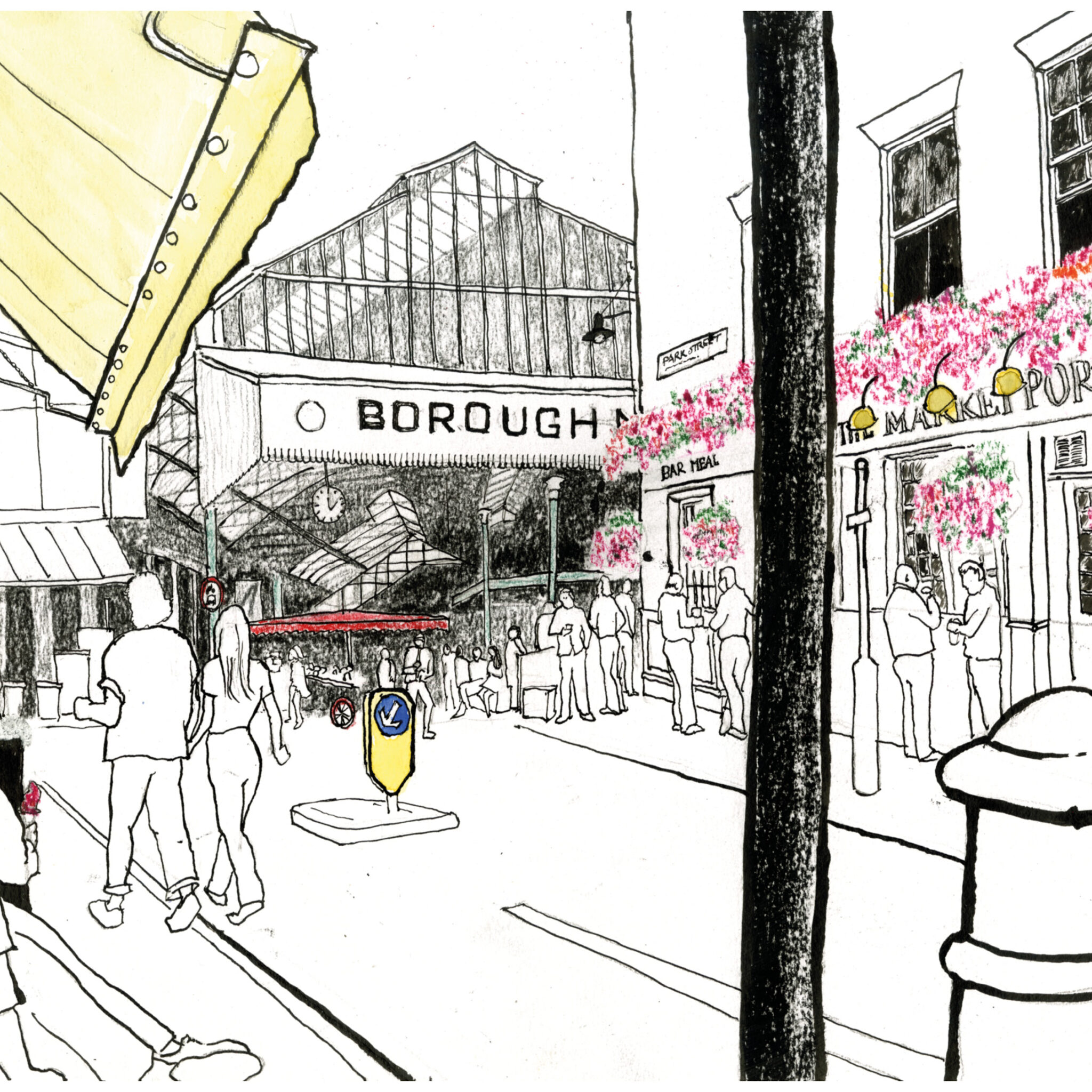What is the draw of people-watching for creatives?
‘If you’re people-watching, you see how it’s a story evolving in front of you,’ says London-based artist David Richardson, whose work captures the scenes unfolding in the capital’s public spaces, be that a fish market or outside the Houses of Parliament. ‘You notice more, too, when you spend time looking at something for a long while.’ That’s when the details emerge – the passer-by taking snapshots on their phone, someone walking in an unusual way.
But how does he decide where to stop and – politely – stare? ‘I find a scene that I feel is unusual, dramatic or has context,’ he says. ‘It’s interesting to sit there and watch the scene change – it’s like watching a movie.’ He cautions, however, that sometimes the observer becomes more an active part of the scene than might be intended or wanted: ‘People often come up and start chatting to me, even telling me their life stories.’
Jess Isted, a poet who lives in Staffordshire in the UK, regularly derives inspiration from people-watching. ‘If I’m ever in a slump or get writer’s block, I always go to the local park and sit on a bench by the lake and feed the ducks and geese, and just observe,’ she says. ‘It always gets me motivated again. I don’t really go out to specific places – I’m more of a general people and environment watcher. If I’m travelling or just popping to the shops or walking to work, I pay attention to all the tiny details. I once observed a man in a café through the window who looked upset, and then I realised that everyone in there looked upset or sad, so composed a poem about it.’
This focus on daily minutiae is shared by Anahita Harding, a visual and performance artist from London. ‘My daily life is where I feel inspired by the people around me, interactions I have, both good and bad, and watching how people move through spaces and interact with each other or their surroundings at different times of day or in different contexts,’ says Anahita, whose art often explores her experience as a wheelchair user and the ways people respond to her.
For Anahita, her performance art is also a way to observe others. In July 2022, her performance of Are You Comfortable Yet? at Tate Modern in London, encouraged visitors to reflect on their relationship to bodily difference. The performance involved Anahita wearing swimwear and sitting completely still while riding up and down the lifts in the gallery for several hours, noticing how people reacted to her. ‘In my performances I am often still, and I think I end up seeing the “true” side of some people as they think I can’t hear or respond to what they are saying – it isn’t always pleasant,’ she says. ‘Other times in daily life, I see the lovely side of people, perhaps a stranger helps someone to carry their shopping or gives directions or offers a seat, without thinking anyone has noticed.’
What are the best ways to people-watch?
Some creatives will watch a scene for several hours at a time – David recalls being in one spot for six hours as he observed the comings and goings, the interactions, the snippets of life.
When he wanted to create artwork at the Natural History Museum in London, he took himself high into the building to get more of a bird’s-eye view. ‘I could see all these people, almost like ants, underneath, moving around, with contrasts between sizes, which gave it real depth,’ he says. At other times, however, he positions himself almost in the middle of the action, perhaps in a market or at a protest march. From such a close spot, he can see, hear and feel the action. Either way, he draws as much as he can in situ, adding colour and further touches down the line.
For others, the act of people-watching is more incidental. ‘It just happens when it happens for me,’ says Anahita. ‘Maybe it’s on the bus, on the train or in a café. Sometimes I sketch in public, but I often feel self-conscious. I sketch if I’m in a quiet spot and try to do this whenever I can. Usually, I’ll make a mental note and write or sketch once I’m at home.’
Poet Jess has a similar pattern. ‘If I’m in full flow, I’ll write the whole poem there and then,’ she says. ‘If not, I’ll take down notes, phrases or sayings in a notebook or on my phone and sit and organise them later. When I worked as a cashier, I even wrote poetry snippets on the back of till receipts.’ One of her favourite places, however, is a theme park. ‘I absolutely love them,’ she says, ‘and some have 60-120-minute queues for the rides, so the notes app on my phone is usually full by the end of the day, from writing down things I notice while waiting.’ She uses anything that comes to hand, though, so it’s no surprise that her drawers are full of beer mats, tickets and envelopes, all covered with poetic snippets or complete works.
How to select details from your observations to create art
Whether it’s two hours in a theme-park queue or five minutes on the bus, observing a scene gives an artist an opportunity to see the depth of a place and the people who pass through it. There will always be decisions, however, as to which details are kept in and those that are left out.
‘Some details just don’t appeal to me or don’t fit the feelings or style I’m in the mood for at the time,’ says Jess. ‘If I have an idea of something I want to write, I’ll deliberately seek out the interactions I need or want.’ She’ll also change ideas or include additional notes to enhance her verse. ‘It’s like telling an anecdote, then a friend retelling the anecdote with their own style and additions and flair,’ she says. ‘If I can’t hear what people are saying, I try to make up my own captions and subtitles for the conversation. I try putting myself in their situation – everyone has a story to tell.’
The way a scene lends itself to the art is important to David, too. ‘I’m interested in shapes and the interaction of how people stand and how they walk,’ he says, and this influences his choices and compositions. Anahita’s choices also vary. ‘If my work is based on writing, which it sometimes is, I use quotes and keep them as they are,’ she says. ‘With performance, the interactions I witness or have been in serve as the basis of the work, rather than the actual work itself.’
Whether you’re sitting on a park bench, in a café or on the bus, there are many opportunities to observe life’s goings-on and the interactions that make up the rhythm of a place, a moment, a scene. Perhaps next time you find yourself with time on your hands while out and about, you might watch what’s going on around you and see how it piques the imagination.
View more of David’s work on Instagram @davidrichartson and on his Etsy shop RDavidRichardsonArt. He’s also illustrated and co-authored The Walking Guide to London Film Sites, available now. Follow Jess on Instagram @jesspoetry42 and find Anahita @ billinghurst_collective and on X (formerly Twitter) @AYCY_Anahita
You can read more articles about art and creativity in the latest issue of Breathe magazine.


